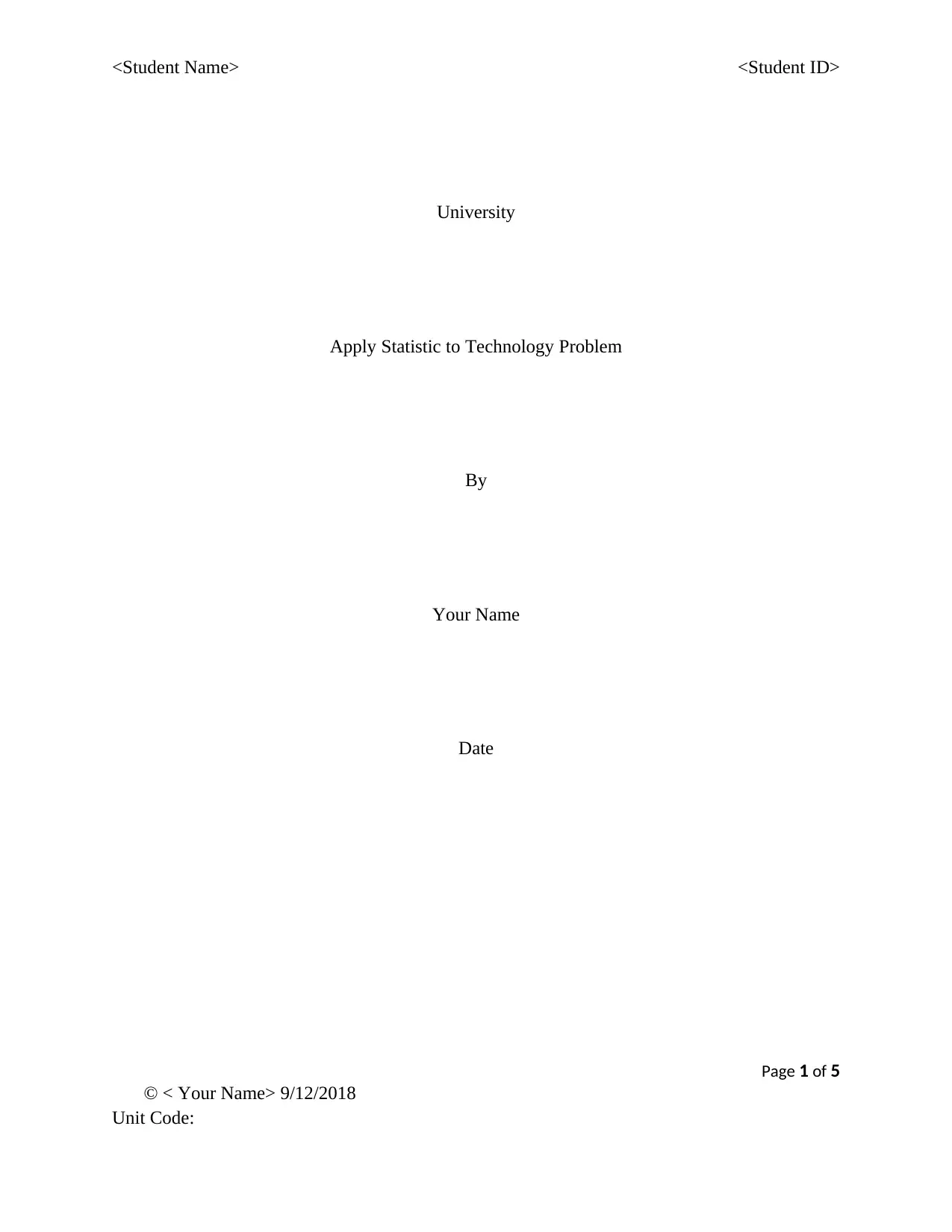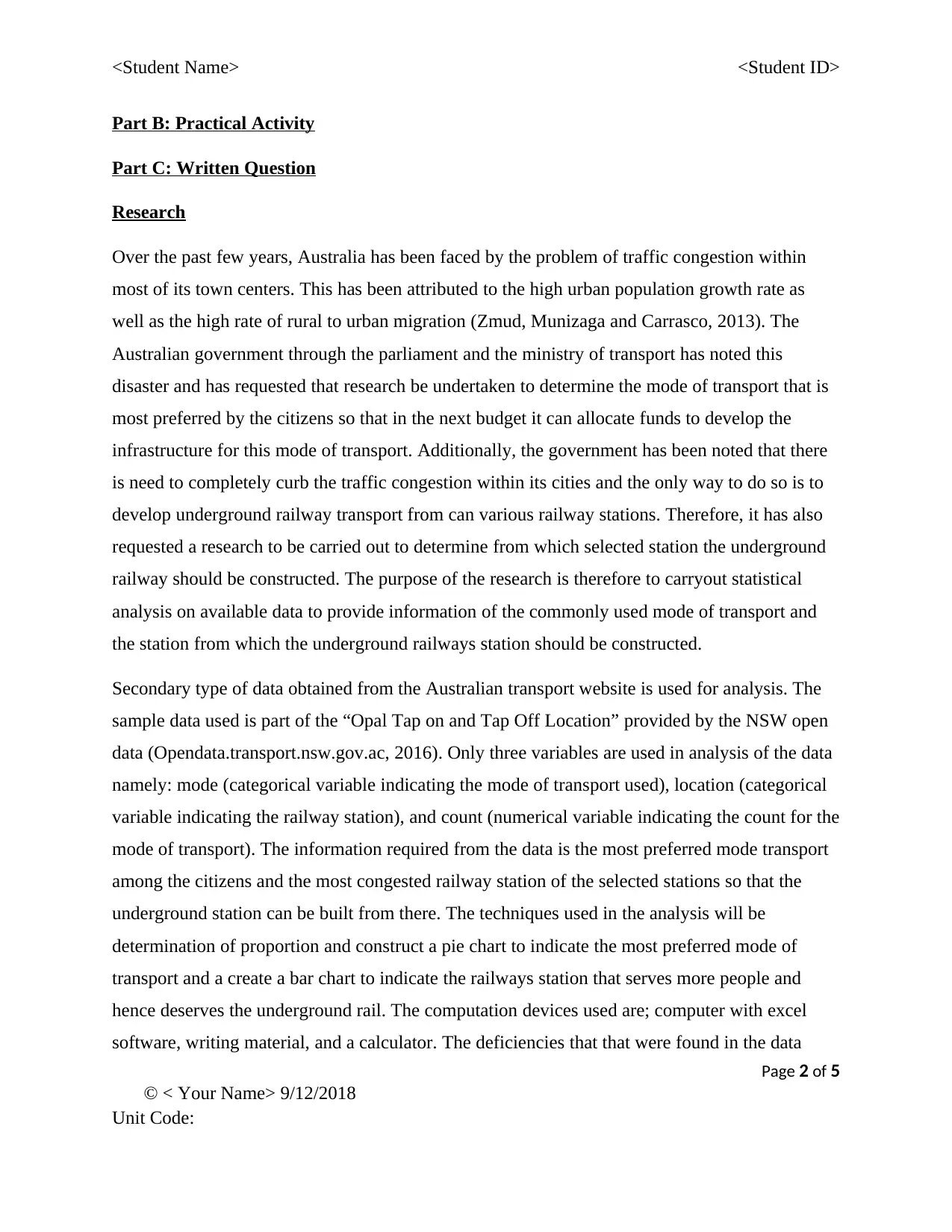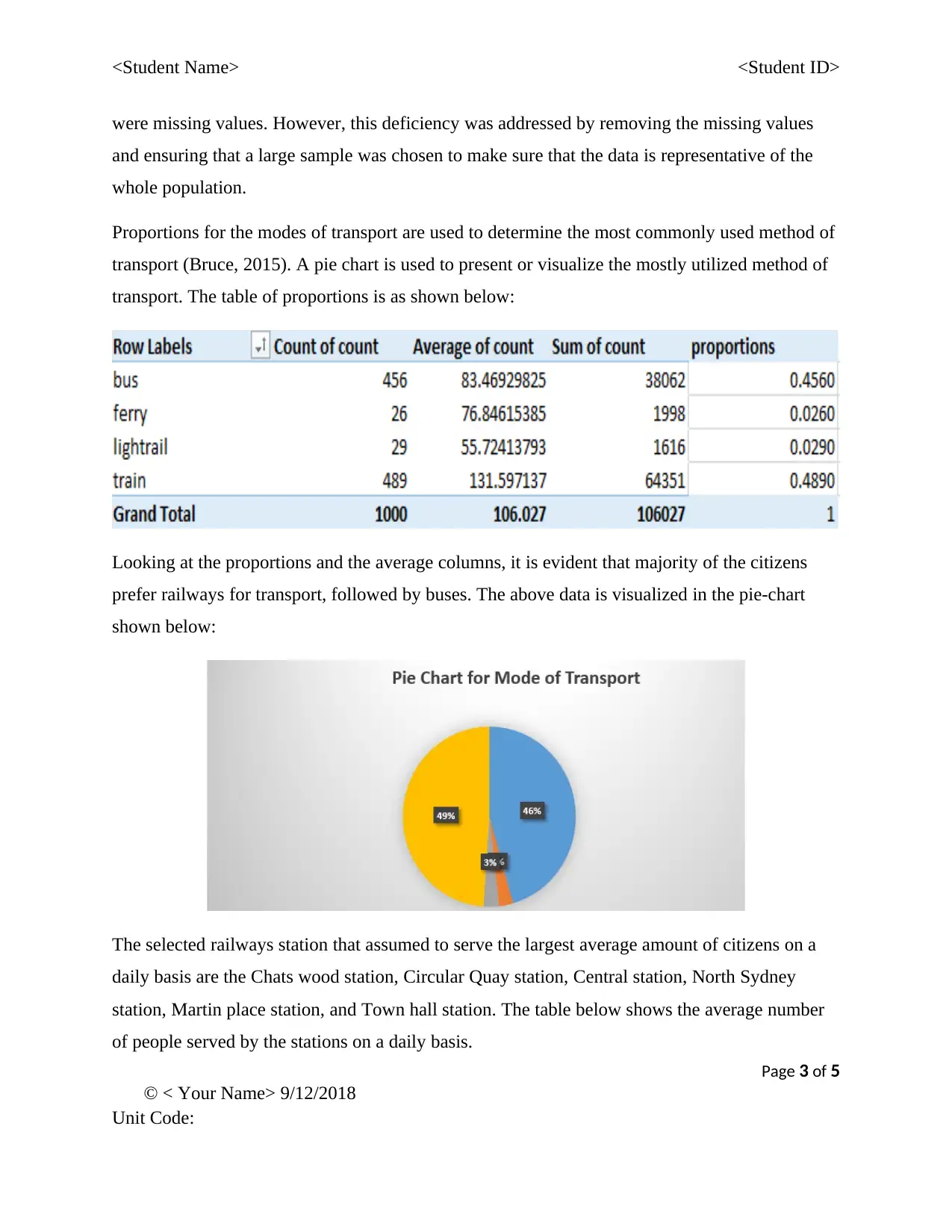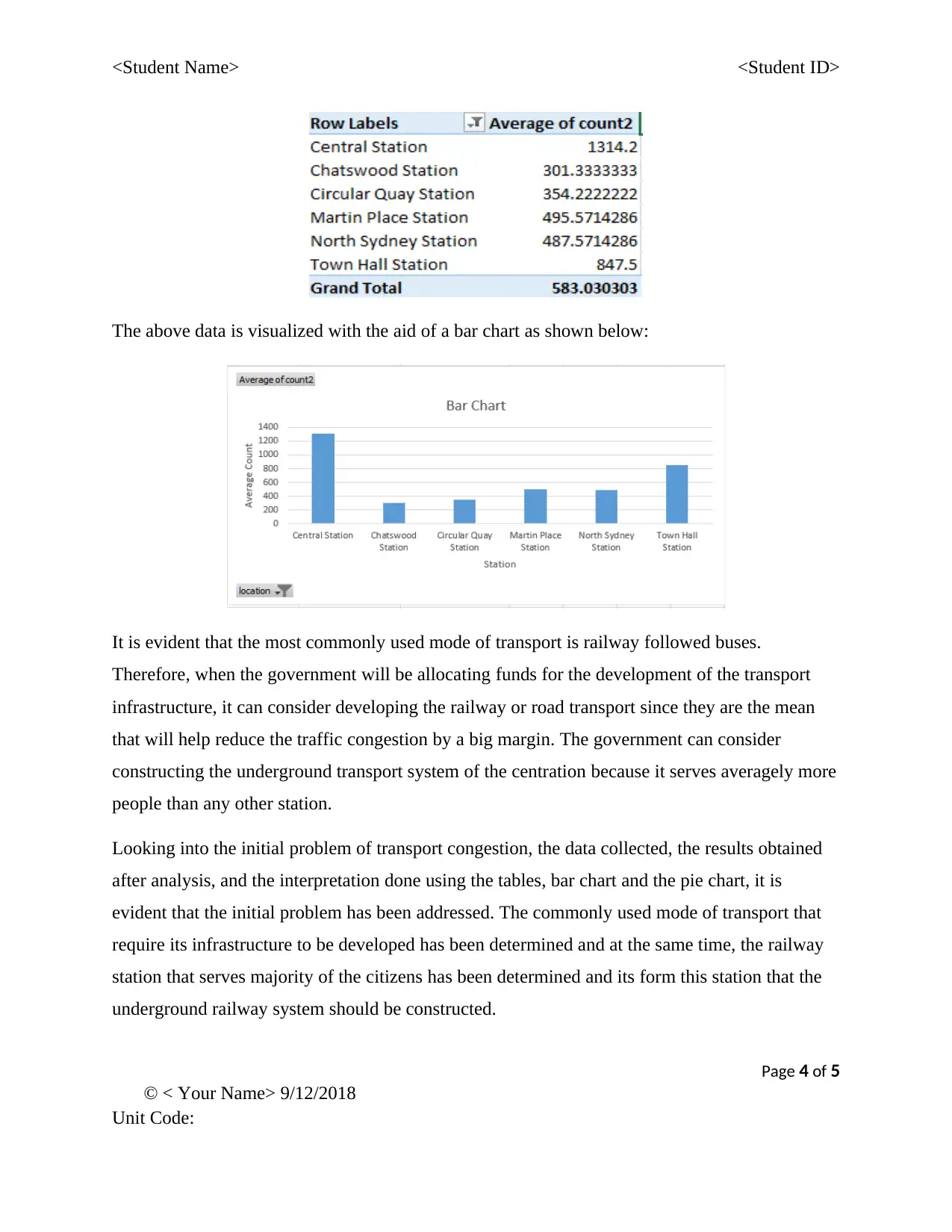Apply Statistics to Technology Problems: Traffic Congestion Report
VerifiedAdded on 2023/05/28
|5
|991
|387
Report
AI Summary
This report presents a statistical analysis of traffic congestion in Australia, addressing a government request to determine the most preferred mode of transport and the optimal location for an underground railway station. The study uses secondary data from the NSW open data, focusing on mode of transport, location, and count. The analysis employs proportions and visualizes data with pie and bar charts to identify the most commonly used transport method and the busiest railway station. Findings indicate that railways are the most preferred mode, and Central station serves the largest number of people. The report concludes that the government should prioritize railway infrastructure development and construct the underground railway from Central station to alleviate traffic congestion effectively. The report also discusses data deficiencies and the methods to address them.

<Student Name> <Student ID>
University
Apply Statistic to Technology Problem
By
Your Name
Date
Page 1 of 5
© < Your Name> 9/12/2018
Unit Code:
University
Apply Statistic to Technology Problem
By
Your Name
Date
Page 1 of 5
© < Your Name> 9/12/2018
Unit Code:
Paraphrase This Document
Need a fresh take? Get an instant paraphrase of this document with our AI Paraphraser

<Student Name> <Student ID>
Part B: Practical Activity
Part C: Written Question
Research
Over the past few years, Australia has been faced by the problem of traffic congestion within
most of its town centers. This has been attributed to the high urban population growth rate as
well as the high rate of rural to urban migration (Zmud, Munizaga and Carrasco, 2013). The
Australian government through the parliament and the ministry of transport has noted this
disaster and has requested that research be undertaken to determine the mode of transport that is
most preferred by the citizens so that in the next budget it can allocate funds to develop the
infrastructure for this mode of transport. Additionally, the government has been noted that there
is need to completely curb the traffic congestion within its cities and the only way to do so is to
develop underground railway transport from can various railway stations. Therefore, it has also
requested a research to be carried out to determine from which selected station the underground
railway should be constructed. The purpose of the research is therefore to carryout statistical
analysis on available data to provide information of the commonly used mode of transport and
the station from which the underground railways station should be constructed.
Secondary type of data obtained from the Australian transport website is used for analysis. The
sample data used is part of the “Opal Tap on and Tap Off Location” provided by the NSW open
data (Opendata.transport.nsw.gov.ac, 2016). Only three variables are used in analysis of the data
namely: mode (categorical variable indicating the mode of transport used), location (categorical
variable indicating the railway station), and count (numerical variable indicating the count for the
mode of transport). The information required from the data is the most preferred mode transport
among the citizens and the most congested railway station of the selected stations so that the
underground station can be built from there. The techniques used in the analysis will be
determination of proportion and construct a pie chart to indicate the most preferred mode of
transport and a create a bar chart to indicate the railways station that serves more people and
hence deserves the underground rail. The computation devices used are; computer with excel
software, writing material, and a calculator. The deficiencies that that were found in the data
Page 2 of 5
© < Your Name> 9/12/2018
Unit Code:
Part B: Practical Activity
Part C: Written Question
Research
Over the past few years, Australia has been faced by the problem of traffic congestion within
most of its town centers. This has been attributed to the high urban population growth rate as
well as the high rate of rural to urban migration (Zmud, Munizaga and Carrasco, 2013). The
Australian government through the parliament and the ministry of transport has noted this
disaster and has requested that research be undertaken to determine the mode of transport that is
most preferred by the citizens so that in the next budget it can allocate funds to develop the
infrastructure for this mode of transport. Additionally, the government has been noted that there
is need to completely curb the traffic congestion within its cities and the only way to do so is to
develop underground railway transport from can various railway stations. Therefore, it has also
requested a research to be carried out to determine from which selected station the underground
railway should be constructed. The purpose of the research is therefore to carryout statistical
analysis on available data to provide information of the commonly used mode of transport and
the station from which the underground railways station should be constructed.
Secondary type of data obtained from the Australian transport website is used for analysis. The
sample data used is part of the “Opal Tap on and Tap Off Location” provided by the NSW open
data (Opendata.transport.nsw.gov.ac, 2016). Only three variables are used in analysis of the data
namely: mode (categorical variable indicating the mode of transport used), location (categorical
variable indicating the railway station), and count (numerical variable indicating the count for the
mode of transport). The information required from the data is the most preferred mode transport
among the citizens and the most congested railway station of the selected stations so that the
underground station can be built from there. The techniques used in the analysis will be
determination of proportion and construct a pie chart to indicate the most preferred mode of
transport and a create a bar chart to indicate the railways station that serves more people and
hence deserves the underground rail. The computation devices used are; computer with excel
software, writing material, and a calculator. The deficiencies that that were found in the data
Page 2 of 5
© < Your Name> 9/12/2018
Unit Code:

<Student Name> <Student ID>
were missing values. However, this deficiency was addressed by removing the missing values
and ensuring that a large sample was chosen to make sure that the data is representative of the
whole population.
Proportions for the modes of transport are used to determine the most commonly used method of
transport (Bruce, 2015). A pie chart is used to present or visualize the mostly utilized method of
transport. The table of proportions is as shown below:
Looking at the proportions and the average columns, it is evident that majority of the citizens
prefer railways for transport, followed by buses. The above data is visualized in the pie-chart
shown below:
The selected railways station that assumed to serve the largest average amount of citizens on a
daily basis are the Chats wood station, Circular Quay station, Central station, North Sydney
station, Martin place station, and Town hall station. The table below shows the average number
of people served by the stations on a daily basis.
Page 3 of 5
© < Your Name> 9/12/2018
Unit Code:
were missing values. However, this deficiency was addressed by removing the missing values
and ensuring that a large sample was chosen to make sure that the data is representative of the
whole population.
Proportions for the modes of transport are used to determine the most commonly used method of
transport (Bruce, 2015). A pie chart is used to present or visualize the mostly utilized method of
transport. The table of proportions is as shown below:
Looking at the proportions and the average columns, it is evident that majority of the citizens
prefer railways for transport, followed by buses. The above data is visualized in the pie-chart
shown below:
The selected railways station that assumed to serve the largest average amount of citizens on a
daily basis are the Chats wood station, Circular Quay station, Central station, North Sydney
station, Martin place station, and Town hall station. The table below shows the average number
of people served by the stations on a daily basis.
Page 3 of 5
© < Your Name> 9/12/2018
Unit Code:
⊘ This is a preview!⊘
Do you want full access?
Subscribe today to unlock all pages.

Trusted by 1+ million students worldwide

<Student Name> <Student ID>
The above data is visualized with the aid of a bar chart as shown below:
It is evident that the most commonly used mode of transport is railway followed buses.
Therefore, when the government will be allocating funds for the development of the transport
infrastructure, it can consider developing the railway or road transport since they are the mean
that will help reduce the traffic congestion by a big margin. The government can consider
constructing the underground transport system of the centration because it serves averagely more
people than any other station.
Looking into the initial problem of transport congestion, the data collected, the results obtained
after analysis, and the interpretation done using the tables, bar chart and the pie chart, it is
evident that the initial problem has been addressed. The commonly used mode of transport that
require its infrastructure to be developed has been determined and at the same time, the railway
station that serves majority of the citizens has been determined and its form this station that the
underground railway system should be constructed.
Page 4 of 5
© < Your Name> 9/12/2018
Unit Code:
The above data is visualized with the aid of a bar chart as shown below:
It is evident that the most commonly used mode of transport is railway followed buses.
Therefore, when the government will be allocating funds for the development of the transport
infrastructure, it can consider developing the railway or road transport since they are the mean
that will help reduce the traffic congestion by a big margin. The government can consider
constructing the underground transport system of the centration because it serves averagely more
people than any other station.
Looking into the initial problem of transport congestion, the data collected, the results obtained
after analysis, and the interpretation done using the tables, bar chart and the pie chart, it is
evident that the initial problem has been addressed. The commonly used mode of transport that
require its infrastructure to be developed has been determined and at the same time, the railway
station that serves majority of the citizens has been determined and its form this station that the
underground railway system should be constructed.
Page 4 of 5
© < Your Name> 9/12/2018
Unit Code:
Paraphrase This Document
Need a fresh take? Get an instant paraphrase of this document with our AI Paraphraser

<Student Name> <Student ID>
References
Bruce, P. (2015). Introductory statistics and analytics. New Jersey: Wiley.
Opendata.transport.nsw.gov.au. (2016). Opal Tap On and Tap Off | TfNSW Open Data Hub and
Developer Portal. [online] Available at: https://opendata.transport.nsw.gov.au/dataset/opal-tap-
on-and-tap-off [Accessed 22 Sep. 2018].
Zmud, J., Munizaga, M. and Carrasco, J. 2013. Transport survey methods. Emerald Group Pub
Ltd.
Page 5 of 5
© < Your Name> 9/12/2018
Unit Code:
References
Bruce, P. (2015). Introductory statistics and analytics. New Jersey: Wiley.
Opendata.transport.nsw.gov.au. (2016). Opal Tap On and Tap Off | TfNSW Open Data Hub and
Developer Portal. [online] Available at: https://opendata.transport.nsw.gov.au/dataset/opal-tap-
on-and-tap-off [Accessed 22 Sep. 2018].
Zmud, J., Munizaga, M. and Carrasco, J. 2013. Transport survey methods. Emerald Group Pub
Ltd.
Page 5 of 5
© < Your Name> 9/12/2018
Unit Code:
1 out of 5
Related Documents
Your All-in-One AI-Powered Toolkit for Academic Success.
+13062052269
info@desklib.com
Available 24*7 on WhatsApp / Email
![[object Object]](/_next/static/media/star-bottom.7253800d.svg)
Unlock your academic potential
Copyright © 2020–2025 A2Z Services. All Rights Reserved. Developed and managed by ZUCOL.




